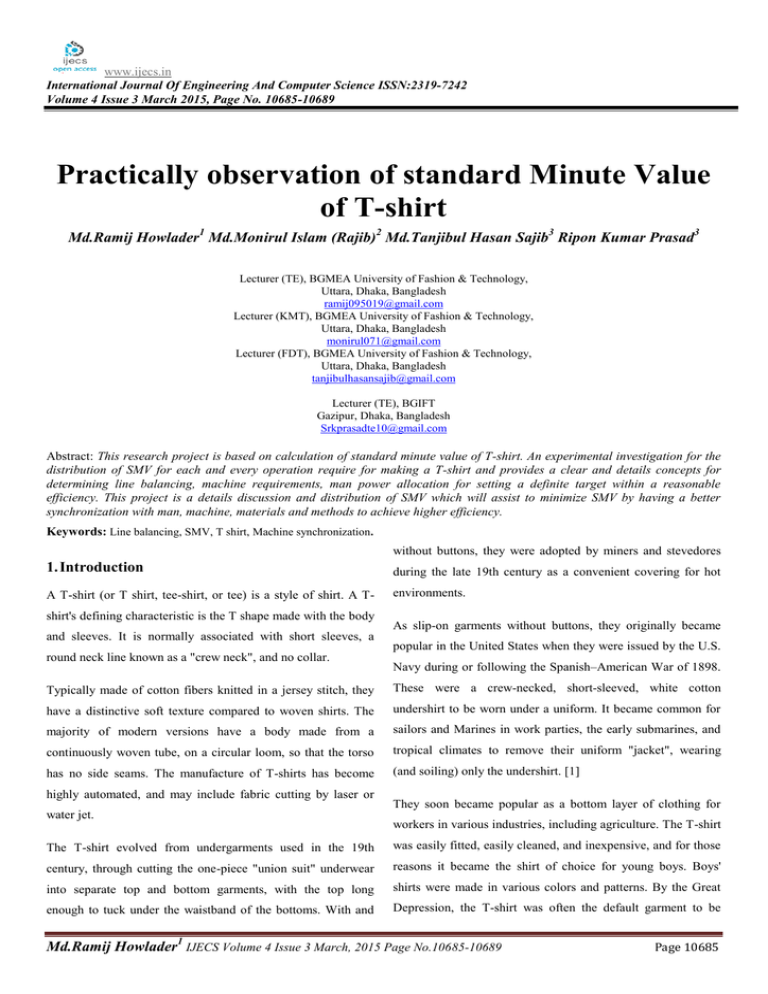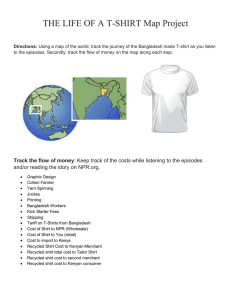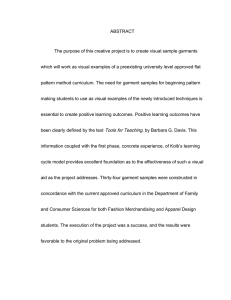www.ijecs.in International Journal Of Engineering And Computer Science ISSN:2319-7242
advertisement

www.ijecs.in International Journal Of Engineering And Computer Science ISSN:2319-7242 Volume 4 Issue 3 March 2015, Page No. 10685-10689 Practically observation of standard Minute Value of T-shirt Md.Ramij Howlader1 Md.Monirul Islam (Rajib)2 Md.Tanjibul Hasan Sajib3 Ripon Kumar Prasad3 Lecturer (TE), BGMEA University of Fashion & Technology, Uttara, Dhaka, Bangladesh ramij095019@gmail.com Lecturer (KMT), BGMEA University of Fashion & Technology, Uttara, Dhaka, Bangladesh monirul071@gmail.com Lecturer (FDT), BGMEA University of Fashion & Technology, Uttara, Dhaka, Bangladesh tanjibulhasansajib@gmail.com Lecturer (TE), BGIFT Gazipur, Dhaka, Bangladesh Srkprasadte10@gmail.com Abstract: This research project is based on calculation of standard minute value of T-shirt. An experimental investigation for the distribution of SMV for each and every operation require for making a T-shirt and provides a clear and details concepts for determining line balancing, machine requirements, man power allocation for setting a definite target within a reasonable efficiency. This project is a details discussion and distribution of SMV which will assist to minimize SMV by having a better synchronization with man, machine, materials and methods to achieve higher efficiency. Keywords: Line balancing, SMV, T shirt, Machine synchronization. without buttons, they were adopted by miners and stevedores 1. Introduction during the late 19th century as a convenient covering for hot A T-shirt (or T shirt, tee-shirt, or tee) is a style of shirt. A T- environments. shirt's defining characteristic is the T shape made with the body and sleeves. It is normally associated with short sleeves, a round neck line known as a "crew neck", and no collar. As slip-on garments without buttons, they originally became popular in the United States when they were issued by the U.S. Navy during or following the Spanish–American War of 1898. Typically made of cotton fibers knitted in a jersey stitch, they These were a crew-necked, short-sleeved, white cotton have a distinctive soft texture compared to woven shirts. The undershirt to be worn under a uniform. It became common for majority of modern versions have a body made from a sailors and Marines in work parties, the early submarines, and continuously woven tube, on a circular loom, so that the torso tropical climates to remove their uniform "jacket", wearing has no side seams. The manufacture of T-shirts has become (and soiling) only the undershirt. [1] highly automated, and may include fabric cutting by laser or water jet. They soon became popular as a bottom layer of clothing for workers in various industries, including agriculture. The T-shirt The T-shirt evolved from undergarments used in the 19th was easily fitted, easily cleaned, and inexpensive, and for those century, through cutting the one-piece "union suit" underwear reasons it became the shirt of choice for young boys. Boys' into separate top and bottom garments, with the top long shirts were made in various colors and patterns. By the Great enough to tuck under the waistband of the bottoms. With and Depression, the T-shirt was often the default garment to be Md.Ramij Howlader1 IJECS Volume 4 Issue 3 March, 2015 Page No.10685-10689 Page 10685 worn when doing farm or ranch chores, as well as other times variety of products to meet customers demand. It is especially when modesty called for a torso covering but conditions called in the apparel industry that managers are trying to develop their for lightweight fabrics [1]. current systems or looking for new production techniques in order to keep pace with the rapid changes in the fashion A V-neck T-shirt has a V-shaped neckline, as opposed to the industry. round neckline of the more common crew neck shirt. V-necks were introduced so that the neckline of the shirt does not stand out when an outer shirt is worn over it, thus reducing or eliminating the visible cloth above the outer shirt of a crew Therefore, to develop a new system, good observation is needed. However to observe real manufacturing systems is very expensive and sometimes cumbersome. neck shirt. The ready-made garment (RMG) sector is the life-blood of The rapid rate at which the whole process takes place, the Bangladesh economy achieving higher export growth every interaction between workers, and the different transition times year. The sector is now the largest contributor not only to between workers make it increasingly more difficult for a overseas trade but also to the national economy. human being to make correct decisions regarding how fast each Bangladesh textiles and RMG industry comprises 1,55,557 operator should work in order to continue the process, while at units – 1,48,000 handlooms units, 3,284 mechanized primary the same time keeping productivity high and throughput at an textile units, 5150 export-oriented readymade garments acceptable level [3]. manufacturing units and 273 garments washing-dyeing units. The sector is a major foreign exchange earner for Bangladesh Construction of a quality garment requires a great deal of contributing 77 percent to the country's net exports. At the end know-how, a lot of coordination and schedule management. of the fiscal year 2011, total export of Bangladesh garments Clothing manufacturing consists of a variety of product was worth US$ 23 billion, a 43 percent increase over the categories, materials and styling. Dealing with constantly previous year, accounting for almost 25 percent of the GDP changing styles and consumer demands is so difficult. (gross domestic product) [1]. Furthermore, to adapt automation for the clothing system is also so hard because, beside the complex structure also it is A growing number of chief purchasing officers (CPOs) in labor intensive. Therefore, garment production needs properly European and apparel companies are scrutinizing their sourcing rationalized manufacturing technology, management and strategies, as margin and supplier capacity pressure building planning [4]. In garment production, until garment components over the last several years has caused them to search for the are gathered into a finished garment, they are assembled next performance improvement opportunity. through a sub-assembly process. The production process includes a set of workstations, at each of which a specific task While China is starting to lose its attractiveness in this realm, is carried out in a restricted sequence, with hundreds of the sourcing caravan is moving on to the next hot spot. With employees and thousands of bundles of sub-assemblies Bangladesh having developed a strong position among producing different styles simultaneously [5]. The joining Europeans and US buyers, many companies are already eager together of components, known as the sewing process which is evaluate the future potential. However, the lure of competitive the most labor intensive part of garment manufacturing, makes prices, available capacities and suppliers capacities offered is the structure complex as the some works has a priority before being cautiously weighed against a prevailing insecurity being assembled [6]. created by the challenges inherent in Bangladesh’s ReadyMade Garments (RMG) market [2]. Furthermore, since sewing process is labor intensive; apart from material costs, the cost structure of the sewing process is Today’s business climate for clothing manufacturers requires also important. Therefore, this process is of critical importance low inventory and quick response systems that turn out a wide and needs to be planned more carefully [7]. As a consequence, Md.Ramij Howlader1 IJECS Volume 4 Issue 3 March, 2015 Page No.10685-10689 Page 10686 good line balancing with small stocks in the sewing line has to 80% - 90% of efficiency, whereas in Bangladesh, according to be drawn up to increase the efficiency and quality of some experts, productivity is between 35% and 55% of production. An assembly line is defined as a set of distinct efficiency with very few exceptions. For the RMG sector in tasks which is assigned to a set of workstations linked together Bangladesh, productivity alone can make a difference between by a transport mechanism under detailed assembling sequences life and death [12]. specifying how the assembling process flows from one station to another. In assembly line balancing, allocation of jobs to 2. Materials machines is based on the objective of minimizing the workflow among the operators, reducing the throughput time as well as the work in progress and thus increasing the productivity. Sharing a job of work between several people is called division of labor. Division of labor should be balanced equally by ensuring the time spent at each station approximately the same. Each individual step in the assembly of product has to be analyzed carefully, and allocated to stations in a balanced way over the available workstations. Each operator then carries out operations properly and the work flow is synchronized. In a detailed work flow, synchronized line includes short distances 2.1 Material used: 1) single jersey (Hundred percent cotton,lycra) 2) Pattern paper 3) Measuring Tape 4) Scissors 5) Pencil 6) Eraser 7) Curve Ruler 8) Stop watch 9) Calculator etc. between stations, low volume of work in process, precise of planning of production times, and predictable production quantity [8]. Overall, the important criteria in garment production is whether assembly work will be finished on time for delivery, how machines and employees are being utilized, whether any station in the assembly line is lagging behind the schedule and how the assembly line is doing overall [9] [10]. To achieve this approach, work-time study, assembly line balancing and simulation can be applied to apparel production line to find 3. Method 3.1 Operation sequence Sewing step 1: Place front and back pieces together with right sides facing. Match the pieces up at the shoulder and pin them if you want. Here they are surged together. Before I had serge I would sew the seam, then zigzag the edges together because I don't like unfinished edges. Sewing step 2: Pin the top center of the sleeve to the shoulder seam. Pin the front and back edges of the sleeve seam. This is kind of difficult to show in a photo alternative solutions to increase the efficiency of the sewing line [11]. Sewing step 3: Fold the shirt so the front and back line up and the sleeve edges line up. Starting at the sleeve hem edge, and Since the late 1970s, the RMG industry started developing in Bangladesh primarily as an export-oriented industry and the domestic market for RMG has been increasing fast due to increase in personal disposable income and change in life style. The sector rapidly attained high importance in terms of employment, foreign exchange earnings and its contribution to GDP. Since buyer comes to this region for the lowest labor all at once, sew the sleeve edges together, then the front and back together at the sides. Do both sides Sewing step 4: Sewing the neckband on is explained here in Tshirt Sewing step 5: Fold the sleeve edges and bottom edge up once and stitch in place. I have a "why you don't need a free arm to sew hems of small sleeves". price ($0.11 per shirt for Bangladesh, $0.26 for India, $0.79 for Srilanka), the quality of the garments, efficiency and productivity of Bangladesh RMG sector remain ignored even in 3.2 Line Balancing of T-Shirt Manufacturing Process for 180 Pieces per Hour the tough competitive market. Factories in Srilanka operate at Md.Ramij Howlader1 IJECS Volume 4 Issue 3 March, 2015 Page No.10685-10689 Page 10687 Sum up all elemental time and convert seconds into Operation no. 01 02 03 04 05 06 07 08 09 10 11 12 Total Operation Shoulder joining(O/L) Over locking of lining-(O/L) Neck piping(O/L) Neck joining(O/L) Neck overclocking(O/L) Sleeve hem-(F/L) Sleeve joining(O/L) Side joining-(O/L) Side top stitch(F/L) Side tuck cuff(SNLS) Neck top stitch(F/L) Bottom hem (F/L) No. of M/C 1 minutes. This is Standard Minute Value (SMV). 1 1 Let, 1 Cycle time = 5.12 minute 1 Performance Rating = 80% 1 2 Bundle allowance, M/C allowance & Personal allowance = 3 2 20% SMV or Standard minute 1 = Normal or Basic time + Allowance% 1 = [Cycle time (minute) x Performance rating %)] +Allowance % 1 16 = [5.12 x 80/100] + Allowance% Table 1: Line Balancing of T-Shirt = 4.096 + [(20 x 4.096)/100] = 4.096+0.8192 3.3 SMV study for a T-shirt = 4.9152 Minute No. 01 02 03 04 05 06 07 08 09 10 11 12 TOTAL SMV Operation Shoulder joining Over locking of lining Neck piping Neck joining Neck overclocking Sleeve hem Sleeve joining Side joining Side top stitch Side tuck cuff Neck top stitch Bottom hem Average Cycle time (sec) Estim ated 13.09 10.90 SMV 0.30 0.25 13.09 15.27 13.09 0.30 0.35 0.30 13.96 26.18 34.90 26.18 26.18 15.27 15.27 0.32 0.60 0.80 0.60 0.60 0.35 0.35 5.12 References [1] Rahman Mizanur, (Thursday, 06 December 2012). RMG sector: Secret of success and causes of unrest, senior vicep resident (IBBL), [2] Berg Achim, November 2011, Principal, McKinsey’s Frankfurt, Co-coordinator, McKinsey’s Apparels, Apparel, Fashion & Luxury Practice, [3] Mücella G. Güner, Can Ünal, Department of Textile Engineering, Faculty of Engineering, University ofEge, Izmir, Turkey, Line Balancing in the Apparel industry Using Simulation Techniques, FIBRES & TEXTILES in Eastern Europe April / June 2008, Vol. 16, No. 2 (67), p75. [4] Table 2: SMV of T-Shirt 4. Result & Calculation SMV means standard minute value. It is a numerical value which is represented the standard time of a process or operation in a standard environment for standard worker. To convert cycle time to normal or basic time we have to multiply it with operator performance rating. Here for example, if rating 100%. Now we have add allowances for machine allowances, fatigue and personal needs etc. Add machine allowance only to those elements where machine is running and fatigue and personal needs to all elements. Now we got standard time for each element in seconds. Glock, R. E. & Kunz, G. I. (1995). Apparel Manufacturing-Sewn Product Analysis, Prentice Hall, New Jersey, p:4 [5] Chuter, A. J. (1988). Introduction to Clothing Production Management, Blackwell Science, Oxford, pp. 60-63. [6] Cooklin, G. (1991). Introduction to Clothing Manufacturing, Blackwell Science, Oxford, p. 104. [7] Tyler, D. J. (1991). Materials Management In Clothing Production, BSP Professional Books Press, London. [8] Eberle, H., Hermeling, H., Hornberger, M., Kilgus, R., Menzer, D., Ring, W., (2004). ClothingTechnology, Beuth-Verlag GmbH, Berlin. [9] Glock, R. E. & Kunz, G. I. (1995). Apparel Manufacturing-Sewn Product Analysis, Prentice Hall, New Jersey, p: 4. [10] Hui, C. & Ng, S. (1999). A study of the effect of time variations for assembly line balancing in the clothing Md.Ramij Howlader1 IJECS Volume 4 Issue 3 March, 2015 Page No.10685-10689 Page 10688 industry International Journal of Clothing Science and Technology, Vol.11, pp. 181-188. [11] Kursun, S. & Kalaoglu, F. (2009). Simulation of Production Line Balancing in Apparel Manufacturing, FIBRES & TEXTILES in Eastern Europe Vol. 17, No. 4 (75), pp.68-71. [12] Labor Management in Development Journal, 2001, Vol.2 Number 7 P.5. Author Profile Md. Monirul Islam (Rajib)2 received the B.Sc.degree in Apparel Manufacture & Technology from BGMEA Institute of Fashion & Technology in 2011. From Jan 2011 to Aug 2014, he worked as merchandiser. From Sep 2014 till date he is engaged in BGMEA University of Fashion & Technology (BUFT) as Lecturer in Knitwear Manufacture & Technology department. Md. Ramij Howlader1 received the B.Sc.degree in Textile Engineering from Dhaka University of Engineering & Technology in 2014. From 2014, i stay in BGMEA University of Fashion & Technology (BUFT) as Lecturer of department of Textile Engineering. Md. Tanjibul Hasan Sajib3 completed B.Sc degree in Fashion Design and Technology from BGMEA Institute of Fashion & Technology in 2013 and started his Teaching career November 2013 at BGMEA University of Fashion and Technology. Science then working in the department of Fashion Design and Technology as a Lecturer at that university. Ripon Kumar Prasad3 received the B.Sc.degree in Textile Engineering from Dhaka University of Engineering & Technology in 2014. From 2014, i stay in BGIFT as Lecturer of department of Textile Engineering. Md.Ramij Howlader1 IJECS Volume 4 Issue 3 March, 2015 Page No.10685-10689 Page 10689






